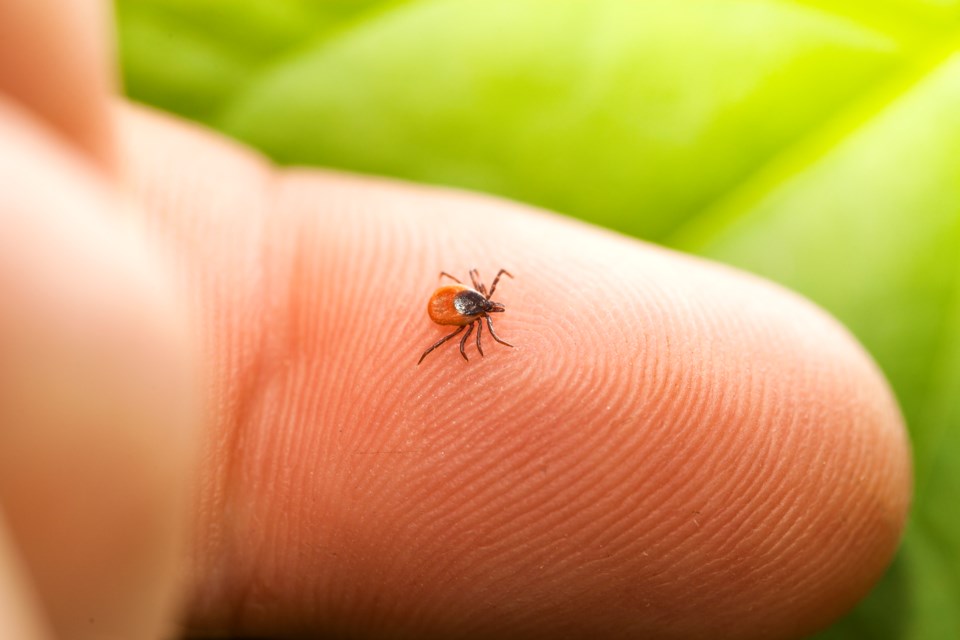The North Bay Parry Sound District Health Unit confirms that since April, three black-legged ticks found in the district have tested positive for the bacterium Borrelia burgdorferi, a bacteria that can cause Lyme disease.
Two of the ticks that tested positive were from the North Bay area, and one was from the Parry Sound area.
So far this year, 37 ticks have been submitted for identification, and 19 have been identified as black-legged ticks, also called deer tick or Ixodes scapularis. Although the number of ticks testing positive for the bacterium Borrelia burgdorferi is seemingly low, the Health Unit reminds the public to exercise caution when outdoors.
There was one confirmed case of Lyme disease reported between January 1, 2020, and December 31, 2020, for residents of the North Bay Parry Sound District Health Unit area.
Black-legged ticks are not common to the area; however, ticks can travel on birds and deer.
Methods to prevent tick bites include:
- Use bug spray or other insect repellants that contain DEET or Icaridin;
- Wear long-sleeved shirts and long pants, and tuck your shirt into your pants and your pants into your socks;
- Wear light-coloured clothing to spot ticks more easily;
- Search your clothes and body for ticks at least once a day, paying special attention to areas such as the groin, navel, armpits, scalp, behind ears and knees;
- Don’t forget to tick check children in your care;
- Try to stay on cleared paths when possible, as ticks are more commonly found in wooded areas, or in tall grasses, bushes and shrubs; and
- Take a shower as soon as you can after being outdoors.
How to remove a tick:
If you find a tick on your body, remove it carefully with tweezers. Grasp the tick by the head as close to the skin as possible. If parts of the tick’s mouth break off and remain in the skin, remove them with tweezers. If you can’t remove the mouthparts, leave them alone and let the skin heal. Collect the tick, and make note of where you believe to have encountered it. See your health care provider right away, and when possible, bring the tick to the Health Unit.
For more information on Lyme disease, please visit the Health Unit website at www.myhealthunit.ca/
Black-legged ticks can carry Lyme disease. Ticks are small blood-sucking insects that cannot fly. They live in wooded or brushy areas and attach themselves to passing animals or people. While most ticks do not carry diseases, it’s important to avoid them and check for and remove them as soon as you find them.
- A person can become infected with Lyme disease if they are bitten by an infected tick.
- In most cases, the tick must usually be attached for at least 24 hours for the bacterium that causes Lyme disease to be passed on to the host.
- The most common symptom of Lyme disease is an expanding skin rash, which can appear between three and 30 days after a bite.
- If left untreated, other symptoms may develop including fever, chills, headache, fatigue muscle and joint aches, problems with your heartbeat, breathing, balance and short-term memory.
- The earlier the treatment is received the better.
- There has been an increase in confirmed cases of Lyme disease in Ontario, partly due to an increase and expansion of black-legged tick populations to new areas of the province.
- Infected ticks are continuing to spread and can now also be found in the Simcoe-Muskoka district, York Region and all of Eastern Ontario as well as Hamilton and parts of Northwestern Ontario. For more information, including the Lyme disease risk area map, go to: https://www.
publichealthontario.ca/en/ diseases-and-conditions/ infectious-diseases/vector- borne-zoonotic-diseases/lyme- disease.



